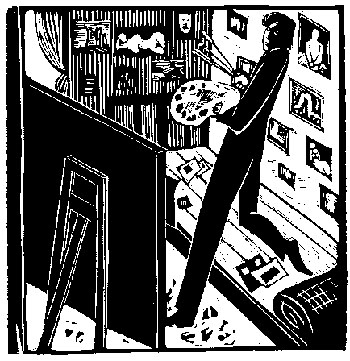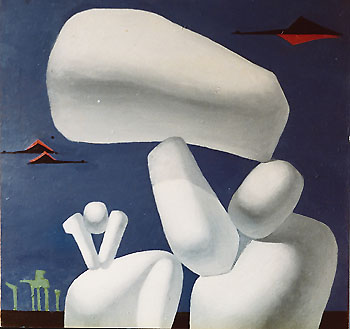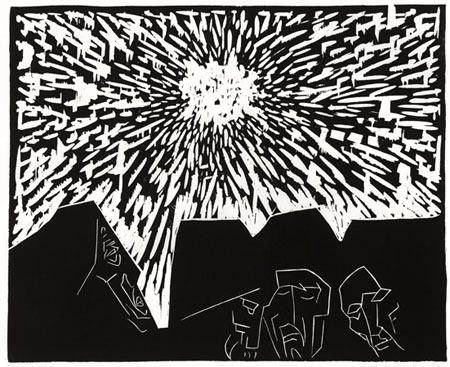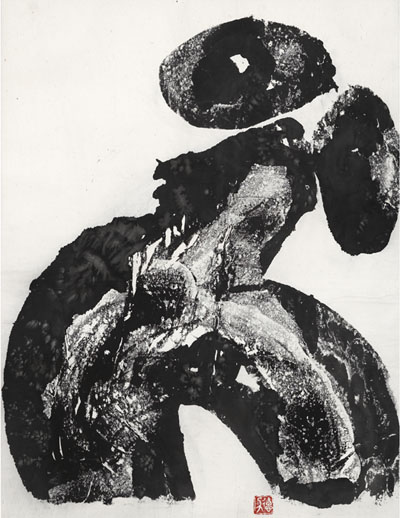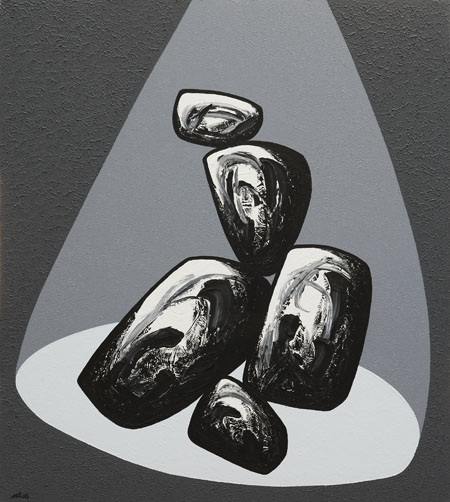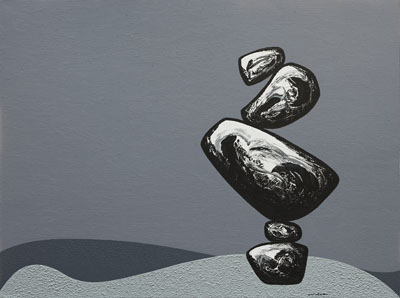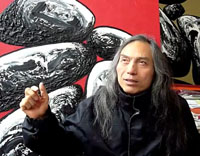| Ma Desheng |  |
Stars and Stones
by Michèle Vicat
 Ma Desheng photographed in his Paris studio by Michèle Vicat © 2011 |
Visitors to Ma Desheng’s studio in Paris are often surprised at the contradiction between the physical fragility of the artist who zips down the streets of his neighborhood in a wheelchair, and the impressive large format canvases stacked along the walls. It only takes a moment for Ma Desheng to propel us into his own expansive universe.
|
His eyes, dark, penetrating, constantly moving,
stand out in sharp contrast to the very pale complexion of his
angular face. His long silver hair is tousled and falls down
to his shoulders in fine undulations. He makes me think of a
seagull, tossing shells on a rock in an effort to extract the
substance that will enable him to survive, flying over the ocean
while taunting the waves. In the same way, Ma Desheng soars above
the currents of passing fashion.
Ma Desheng’s
generation had to work in factories during the day, but they
met at night in crowded rooms whose atmosphere was
thick with cigarette smoke and expressed their longing for
democracy and freedom of expression. A new culture was taking
shape by word
of mouth among painters, writers, sculptors, photographers
and poets. There was no public place for artists and intellectuals
to meet. A market for art did not exist. In China, art had
rarely
been an individual affair. People met in groups to play music,
to write poems, to do calligraphy. Art required symbiosis between
creative people. Except that this time, young artists were
not meeting in a superb retreat on a mountain or in an exquisite
garden
for inspiration. The hutongs (traditional houses in alleyways
in Beijing) became the preferred meeting place for youth without
money.
Ten years later, Wu Wenguang’s documentary Bumming in
Beijing: The Last Dreamers (Liulang
Beijing – Zuihou
de Mengxiangzhe)
From December
1978 to the end of 1979, the authorities, in keeping with their
agenda of liberalization, authorized people
to put
posters on what became known as the Wall of Democracy, a
long brick wall
located on Xidan Street, west of Tian’anmen Square.
Many dissidents believed the new line of the Communist Party,
which
exhorted people to “Seek the Truth from Facts.” The
diazibao, or large-character posters, called for political
reforms and even encouraged human rights. Ma Desheng describes
that wall
as “the wall of ideas created for political reasons
by Deng Xiaoping.” Ma Desheng continues, “We,
artists, we thought of creating another wall, a wall for
art. It was a good idea for
young Chinese artists who had no place to exhibit and to
show something different.” That is what people really
needed at that time in China. Something different. For thirty
years, they lived under
the same banner of uniformity: one leader, one ideology,
one costume, one book, one color. Ma Desheng recalls this
period: “We
met several times to find a name for our group. Under Mao,
the sun was taken as the symbol for unification. We thought
that
the stars could become an emblem of our individuality. Everyone
needs
an identity. We did not need one sun for everyone any more.”
The Stars received
the authorization to hang their work on the outside railings
of the Meishuguan, the National Art
Gallery in Beijing (now called the National Art Museum
of China). More
than
20 young artists participated in the Stars Art Exhibition that opened on September 27, 1979. Besides Ma Desheng and
Huang
Rui’s
work, the exhibition included art work by Ai Weiwei, Wang
Keping, Li Shuang, Qu Leilei, Shao Fei and others. Two
days later, the
exhibition was closed by the police for security reasons.
The themes developed by the artists were quite unusual
for a general public.
There were many representations of female nudes and some
abstract work. Ma Desheng showed his woodblock prints.
Woodblock is a traditional
technique in China and Ma Desheng found his own style by
putting large amounts of black in the prints. Black was
a deliberate choice
against the red of the Cultural Revolution. “It was
not a question of technique,” Ma Desheng tells us. “I
never really liked technique as such. For me, the most
important thing
was to project the fire that I had inside me. We, as artists,
we had to be against something. I was young at that time
and I felt
that I had to do something against communism and against
the way people were used to expressing themselves.”
Vision juxtaposes
silence and explosion. The dark, sad, anguished faces of people
are imprisoned in a world that has no detail
and in which shouts are suppressed. A new world explodes
frenetically from a central point – the sun – to form an array of
possibilities. The stars become vessels for hope although they
do not seem to penetrate the darkness of the somber citadel…not
yet…we are in 1980.
It is haunting
to watch Ma Desheng writing the words “la
vie est toujours là” in my catalogue.
Every two to three words, he has to readjust the
pen between his fingers with
his teeth. The pen constantly slips. The strength
is not there. The muscles are weak, but the will
is tenacious. In 1992, a car
accident in Miami, Florida, forced Ma Desheng to
spend two years in hospitals and undergoing physical
reeducation. Today, his wheelchair
is covered with layers of paint: a living testimony
to his obstinacy and indomitable spirit. “After
the car accident, my hands lost their strength. My
gestures are no
longer very
precise.
Before the accident, I was doing ink wash paintings
on paper. It is a
very sensitive technique. The least drop that falls
and it is over. You cannot retouch. Now, I use acrylics.
If something
goes
wrong,
I can scrape and redo the painting. With acrylics,
I
choose to paint stones.”
When looking
closely at the core of the stone, we can feel flesh and blood.
We can recompose a human
landscape
with
breasts, hips
and buttocks. The stone shelters “the fire of the volcano,” as
Ma Desheng likes to describe it. He makes us travel to the source
of the energy. He makes us re-discover the traditional Chinese
landscape in which the body is often represented as a mountain.
He makes us reflect on the notion of the body in a Taoist way,
beyond the material envelope, but included as part of the whole
human personality. In the foreword of the catalogue of the exhibition
on Ma Desheng that was held in 2006 at The University Museum and
Art Gallery at The University of Hong Kong, the curator, Catherine
Kwai, summarizes what has to be seen inside each stone: “ Having
lived a life of homelessness and misery, Ma has
let go his pertinacity and has become more easy-going.
With
a Daoist
mind, Ma has contemplated
and gained a fuller understanding of the nature
of
hidden things.”
The shapes represented by Ma Desheng take on a lightness, a life of their own. It is as if the stones have the ability to move around and to bounce like the small figures in video games for children. They float and it is up to us to recuperate them, to miss them or to go to another level. It is a question of passage between movement and inertia. It is an obligatory rite of passage to find the taste and the aroma of inertia as well as the tranquil fluidity of the movement. Ma Desheng begins a conversation, a conversation about the whole and the unique. The forces inside become part of our reveries. They form their own fantasy. We can almost imagine the stones acquiring a lightness and flying towards other worlds of whose existence we are just beginning to be aware. These stones are the metaphysical reflection of the stars with which we are finally able to unite. |
Ma
Desheng is also a poet...
|
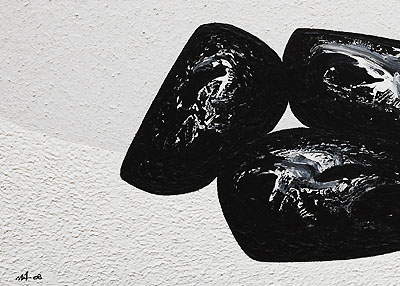 Ma Desheng's Voguer (detail), Acrylic on Canvas, 150 x 200 cm, 2008. photograph by Nicolas Pfeiffer |
All material copyright 2011 by 3DotsWater


